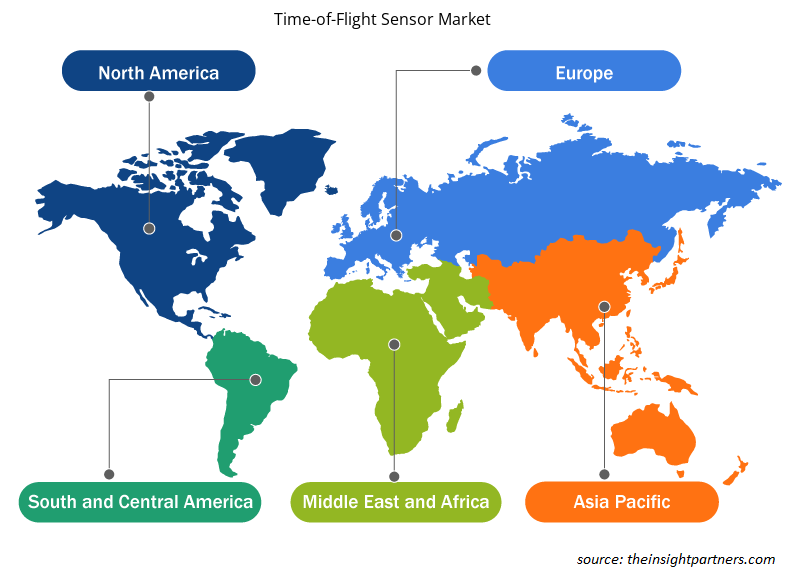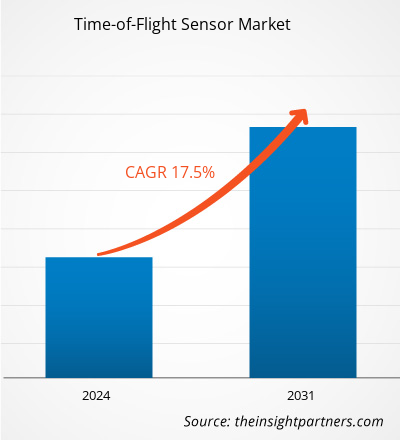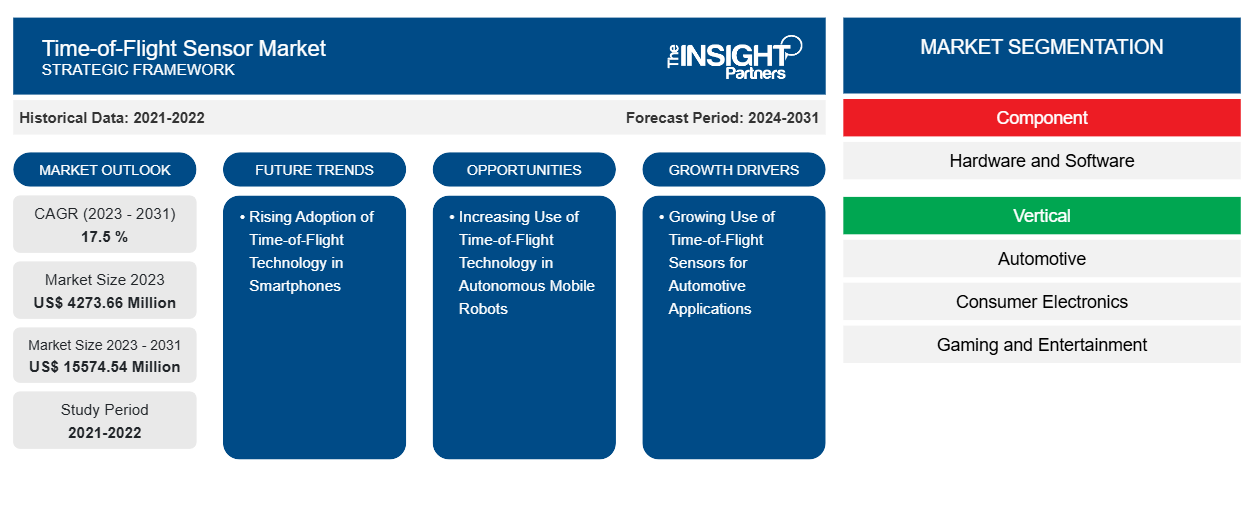Se proyecta que el tamaño del mercado de sensores de tiempo de vuelo alcance los 15 574,54 millones de dólares estadounidenses en 2031, frente a los 4273,66 millones de dólares estadounidenses en 2023. Se espera que el mercado registre una CAGR del 17,5 % durante el período 2023-2031. Es probable que la creciente adopción de la tecnología de tiempo de vuelo en los teléfonos inteligentes siga siendo una tendencia clave en el mercado.
Análisis del mercado de sensores de tiempo de vuelo
La demanda de sensores ToF está aumentando debido a su creciente uso en la industria automotriz. La tecnología se utiliza para monitorear el comportamiento del conductor, lo que ayuda a prevenir accidentes de tránsito y mejorar la seguridad del vehículo. Además, la demanda de sensores está aumentando en otras industrias, como la electrónica de consumo, la atención médica, los juegos y el entretenimiento, y la industria aeroespacial y de defensa. Como resultado, los actores del mercado están creando sensores ToF avanzados. En febrero de 2020, Panasonic Corporation anunció que había desarrollado un sensor de imagen de tiempo de vuelo que utiliza píxeles de fotodiodo de avalancha (APD). Puede adquirir información 3D de alta precisión según la posición de los objetos desde distancias cercanas a lejanas de hasta 250 m. Estos sensores se pueden aplicar en varios campos, como la obtención de imágenes de alcance automotriz y la vigilancia de áreas amplias.
Descripción general del mercado de sensores de tiempo de vuelo
Los sensores de tiempo de vuelo (ToF) se utilizan para medir el tiempo que tarda un objeto en recorrer una distancia a través de un medio. Calcula la diferencia de tiempo entre la emisión de una señal y su retorno al sensor después de ser reflejada por un objeto. El sensor se utiliza para diversas aplicaciones, incluida la navegación de robots, el conteo de personas, el monitoreo de vehículos y la detección de objetos. Es un sistema todo en uno para una integración rentable, fácil y de pequeño tamaño. Proporciona una medición de distancia real sin depender del tamaño, el color y la reflectancia del objetivo. Además, los sensores ToF utilizan láseres para medir largas distancias y rangos con gran precisión.
Personalice este informe según sus necesidades
Obtendrá personalización en cualquier informe, sin cargo, incluidas partes de este informe o análisis a nivel de país, paquete de datos de Excel, así como también grandes ofertas y descuentos para empresas emergentes y universidades.
- Obtenga las principales tendencias clave del mercado de este informe.Esta muestra GRATUITA incluirá análisis de datos, desde tendencias del mercado hasta estimaciones y pronósticos.
Impulsores y oportunidades del mercado de sensores de tiempo de vuelo
Uso creciente de sensores de tiempo de vuelo para aplicaciones automotrices
Junto con los avances en seguridad de los vehículos, la tecnología ToF ofrece comodidad y conveniencia dentro del habitáculo, lo que puede beneficiar a los conductores y pasajeros. Los asientos se pueden mover y los cinturones de seguridad se pueden acercar cuando el pasajero sube al coche. También puede ayudar al conductor o al pasajero encendiendo la luz de los compartimentos de almacenamiento cuando una mano se acerca en esa dirección. Por tanto, el uso creciente de sensores ToF para aplicaciones automotrices está impulsando el crecimiento del mercado de sensores de tiempo de vuelo.
Uso creciente de tecnología de tiempo de vuelo en robots móviles autónomos
En las operaciones de almacén, las cámaras de tiempo de vuelo pueden proporcionar una inteligencia superior para los robots móviles autónomos (AMR) y los vehículos guiados automáticamente (AGV). Las cámaras se pueden utilizar para observar los alrededores y capturar datos de imágenes de profundidad, lo que mejora aún más las funciones críticas para el negocio con precisión, conveniencia y velocidad. La cámara tiene varias funciones, como localización, mapeo, evitación de obstáculos, navegación, detección de objetos y odometría. La demanda de cámaras de tiempo de vuelo está aumentando, lo que permite a los actores del mercado obtener cámaras de tiempo de vuelo tecnológicamente avanzadas. Por lo tanto, estas innovaciones por parte de los participantes del mercado y la creciente adopción de sensores de tiempo de vuelo en AMR están creando oportunidades lucrativas para el mercado de sensores de tiempo de vuelo.
Análisis de segmentación del informe de mercado de sensores de tiempo de vuelo
Los segmentos clave que contribuyeron a la derivación del análisis del mercado de sensores de tiempo de vuelo son el tipo de dispositivo y la vertical.
- Según el tipo de dispositivo, el mercado de sensores de tiempo de vuelo se divide en fuentes de luz moduladas por RF con detectores de fase, sensores de imágenes con control de rango y sensores de imágenes de tiempo de vuelo directo. El segmento de software tuvo una mayor participación de mercado en 2023.
- Por vertical, el mercado está segmentado en automotriz, electrónica de consumo, juegos y entretenimiento, industrial, salud, aeroespacial y defensa, otros.
Análisis de la cuota de mercado de los sensores de tiempo de vuelo por geografía
El alcance geográfico del informe de mercado de sensores de tiempo de vuelo se divide principalmente en cinco regiones: América del Norte, Asia Pacífico, Europa, Oriente Medio y África, y América del Sur y Central. El mercado norteamericano se atribuye a la creciente demanda de sensores de tiempo de vuelo (ToF) en aplicaciones de electrónica de consumo y automoción. Algunas de las funciones de seguridad que ofrece la cámara ToF son la detección de fatiga del conductor exigida por NCAP, la postura del cuerpo, la mirada, la detección de manos en el volante, la aplicación avanzada del cinturón de seguridad y la postura de la cabeza. La función de seguridad del sensor de tiempo de vuelo es beneficiosa para los accidentes de tráfico. Debido a la creciente conciencia de las funciones de seguridad, la demanda de vehículos integrados con la cámara ToF está aumentando en la región de América del Norte.
Perspectivas regionales del mercado de sensores de tiempo de vuelo
Los analistas de Insight Partners explicaron en detalle las tendencias y los factores regionales que influyen en el mercado de sensores de tiempo de vuelo durante el período de pronóstico. Esta sección también analiza los segmentos y la geografía del mercado de sensores de tiempo de vuelo en América del Norte, Europa, Asia Pacífico, Oriente Medio y África, y América del Sur y Central.

- Obtenga datos regionales específicos para el mercado de sensores de tiempo de vuelo
Alcance del informe de mercado de sensores de tiempo de vuelo
| Atributo del informe | Detalles |
|---|---|
| Tamaño del mercado en 2023 | US$ 4273,66 millones |
| Tamaño del mercado en 2031 | US$ 15.574,54 millones |
| CAGR global (2023 - 2031) | 17,5 % |
| Datos históricos | 2021-2022 |
| Período de pronóstico | 2024-2031 |
| Segmentos cubiertos | Por componente
|
| Regiones y países cubiertos | América del norte
|
| Líderes del mercado y perfiles de empresas clave |
|
Densidad de actores del mercado de sensores de tiempo de vuelo: comprensión de su impacto en la dinámica empresarial
El mercado de sensores de tiempo de vuelo está creciendo rápidamente, impulsado por la creciente demanda de los usuarios finales debido a factores como la evolución de las preferencias de los consumidores, los avances tecnológicos y una mayor conciencia de los beneficios del producto. A medida que aumenta la demanda, las empresas amplían sus ofertas, innovan para satisfacer las necesidades de los consumidores y aprovechan las tendencias emergentes, lo que impulsa aún más el crecimiento del mercado.
La densidad de actores del mercado se refiere a la distribución de las empresas o firmas que operan dentro de un mercado o industria en particular. Indica cuántos competidores (actores del mercado) están presentes en un espacio de mercado determinado en relación con su tamaño o valor total de mercado.
Las principales empresas que operan en el mercado de sensores de tiempo de vuelo son:
- Corporación OMRON
- STMicroelectronics NV
- Corporación Keyence
- Teledyne e2v (en el extranjero)
- Holdings Ltd
- Texas Instruments Inc
Descargo de responsabilidad : Las empresas enumeradas anteriormente no están clasificadas en ningún orden particular.

- Obtenga una descripción general de los actores clave del mercado de sensores de tiempo de vuelo
Noticias y desarrollos recientes del mercado de sensores de tiempo de vuelo
El mercado de sensores de tiempo de vuelo se evalúa mediante la recopilación de datos cualitativos y cuantitativos a partir de investigaciones primarias y secundarias, que incluyen publicaciones corporativas importantes, datos de asociaciones y bases de datos. A continuación, se enumeran algunos de los avances en el mercado de sensores de tiempo de vuelo:
- STMicroelectronics presentó nuevos sensores de tiempo de vuelo de alta resolución para imágenes de profundidad 3D avanzadas para teléfonos inteligentes y otros dispositivos. El sensor VD55H1 mapea superficies 3D midiendo la distancia a aproximadamente medio millón de puntos y permite la detección de objetos a una distancia de hasta 5 m del sensor. (Fuente: STMicroelectronics, comunicado de prensa, marzo de 2022).
- TDK Corporation ha lanzado los sensores de tiempo de vuelo ultrasónicos integrados Chirp ICU-10201 e ICU-20201, de consumo ultrabajo y alto rendimiento, para detección de largo y corto alcance. La empresa afirma que los nuevos sensores MEMS ofrecen mediciones de alcance precisas hasta una distancia de 5 m en un campo de visión amplio y configurable. (Fuente: TDK Corporation, comunicado de prensa, enero de 2022)
Informe sobre el mercado de sensores de tiempo de vuelo: cobertura y resultados
El informe “Tamaño y pronóstico del mercado de sensores de tiempo de vuelo (2021-2031)” proporciona un análisis detallado del mercado que cubre las siguientes áreas:
- Tamaño del mercado de sensores de tiempo de vuelo y pronóstico a nivel global, regional y nacional para todos los segmentos clave del mercado cubiertos bajo el alcance
- Tendencias del mercado de sensores de tiempo de vuelo, así como dinámicas del mercado, como impulsores, restricciones y oportunidades clave
- Análisis detallado de las cinco fuerzas de Porter y PEST y FODA
- Análisis del mercado de sensores de tiempo de vuelo que cubre las tendencias clave del mercado, el marco global y regional, los principales actores, las regulaciones y los desarrollos recientes del mercado
- Panorama de la industria y análisis de la competencia que abarca la concentración del mercado, análisis de mapas de calor, actores destacados y desarrollos recientes para el mercado de sensores de tiempo de vuelo
- Perfiles detallados de empresas
- Análisis histórico (2 años), año base, pronóstico (7 años) con CAGR
- Análisis PEST y FODA
- Tamaño del mercado, valor/volumen: global, regional y nacional
- Industria y panorama competitivo
- Conjunto de datos de Excel
Informes recientes
Informes relacionados
Testimonios
Razón para comprar
- Toma de decisiones informada
- Comprensión de la dinámica del mercado
- Análisis competitivo
- Información sobre clientes
- Pronósticos del mercado
- Mitigación de riesgos
- Planificación estratégica
- Justificación de la inversión
- Identificación de mercados emergentes
- Mejora de las estrategias de marketing
- Impulso de la eficiencia operativa
- Alineación con las tendencias regulatorias





















 Obtenga una muestra gratuita para - Mercado de sensores de tiempo de vuelo
Obtenga una muestra gratuita para - Mercado de sensores de tiempo de vuelo